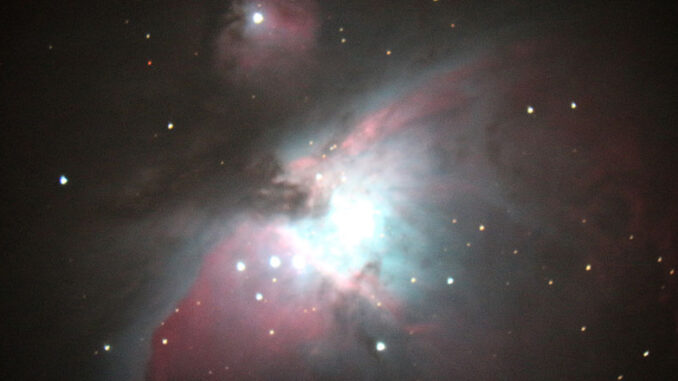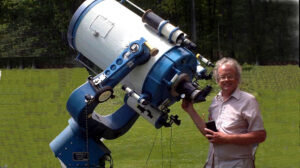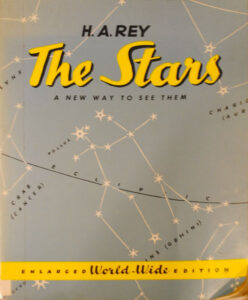
Cold winter air tends to be drier with lower humidity than the summer, which makes it easier to observe stars
By Mary Beth Roach

If you are looking for a new activity to pass the winter months in Central New York, you only need to look up.
The skies can provide you and your family with hours of viewing and learning of constellations and astral phenomenon that will have you over the moon.
Bob Piekiel, a member of the Central New York Observers and Observing group, offers some tips for beginners — how best to see the stars and planets and what can best be seen in the winter skies.
Born in 1961, he was captivated by the Apollo space program during its heyday in the 1960s, and his love of the skies has not dimmed over the years. Pre-pandemic, Piekiel has led public programs at Beaver Lake Nature Center, Baltimore Woods and Green Lakes State Park, for example, and has written as many as 10 books and publications on telescope design, telescope history and certain accessories.
To start your journey of the heavens, Piekiel suggested a book titled “The Stars,” by H.A. Rey, who was famous for his “Curious George” series. Rey illustrates the constellations in the sky by drawing lines between the stars so that they look what they’re actually named for, Piekiel said. The book also shows you how to find them in the night sky during any season; it provides charts for year-round skywatching, and its publisher reprints every several years to keep the information updated.
“That’s your guidepost right there,” he said.
To view the skies, you’ll want a telescope or binoculars. Each instrument has its advantages.
Binoculars have a wider field of view than telescopes, he explained, so you can actually see several objects or several types of objects better, such as star clusters and star fields that are so vast. The telescope will zoom in on a small object and make it appear bigger, brighter and more detailed, he noted. If you want to see the rings of Saturn, the moons of Jupiter, the surface features on mars or craters on the moon, you’re going to need a telescope with higher magnification than binoculars can provide, he added.
When selecting telescopes, Piekiel suggested avoiding those that are too small with a flimsy tripod.
“Get something at least six inches in diameter,” he continued. “The bigger the telescope in diameter, the more light it gathers and the more the objects in the sky look like what they’re supposed to.” He recommends a website called telescope.com, which is owned by a company called Orion, a manufacturer and vendor of telescopes in a variety of sizes.
The cold winter air tends to be drier with lower humidity than the summer, which makes the skies a little bit more transparent, Piekiel said. This means that you can sometimes see fainter stars and fainter objects more consistently in the winter than you can in the summer.
To view the skies, you might not even need to leave your backyard, if you have a good open view. The farther away from the center of a brightly-lit city, and the darker the sky, the more visible things are. A full moon can impact your viewing, too, since it will blot out the faint stars.
“Don’t ever think that the only way to enjoy stargazing is to go to an open field or park, as any area with a view overhead is better than none,” Piekiel noted.
Gazing the stars
Now, you’ve got your guidebook, your telescope, and your viewing spot, so what can you look for over the winter months?

The constellations you see in the winter are different from those in the summer, Piekiel noted. As the earth orbits the sun, the night side of the earth is pointed at different directions in the sky, according to the season. The constellations will stay the same every season. The positions of the planets and the moon will change positions because they orbit the sun, he explained further.
During the winter, the most popular would be the Orion constellation.
“No other constellation has as many bright stars as it does,” Piekiel said.
Its most significant landmark are the three stars that mark its belt. Below that is the Great Orion Nebula, “a big gas cloud giving birth to stars which is visible to the naked eye,” he added. Above Orion is Taurus the Bull, with the Pleiades star cluster, which looks like a tiny, tiny dipper.
Specific astral events include opportunities to view meteors, Jupiter, Saturn, Venus, and to glimpse at Mars.
Piekiel pointed out that each week, Jupiter and Saturn will get lower and lower before sunset, and Venus will be coming up in the western sky after sunset, starting about the middle of December and remaining through the rest of the spring. And according to the American Meteor Society, the Quadrantids will be active from Dec. 27 through Jan. 10. They don’t usually produce trails but have bright fireballs.
And you may even be able to view to a galaxy far, far away without leaving your backyard!
